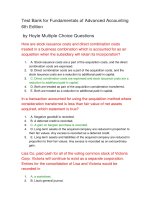Test bank for fundamentals of human neuropsychology 7th edition by kolb
Bạn đang xem bản rút gọn của tài liệu. Xem và tải ngay bản đầy đủ của tài liệu tại đây (50.47 KB, 8 trang )
Name: __________________________ Date: _____________
1. Which subdivision of the peripheral nervous system is responsible for the transmission of sensory signals from the body to
the contralateral side of the brain?
A) the somatic
B) the autonomic
C) the spinal
D) the parasympathetic
2. The brain is organized so that the _____ mediates cognitive functions, the _____ is responsible for regulatory functions like
eating and sleeping, and the _____ is responsible for communication with the motor system.
A) medulla, pons, midbrain
B) left hemisphere, right hemisphere, midbrain
C) forebrain, brainstem, spinal cord
D) amygdala, hippocampus, hypothalamus
3. Who thought that mental processes came from the heart, not the brain?
A) Plato
B) Aristotle
C) Hippocrates
D) Galen
4. If someone believes in a material brain that interacts with a nonmaterial mind, that person would be BEST called a _____.
A) monist
Test Bank for Fundamentals of Human Neuropsychology 7th Edition by Kolb
B) philosopher
C) dualist
Full file at />D) psychologist
5. According to Descartes, which human brain structure was the locus of the mind?
A) the prefrontal lobe
B) the pineal body
C) the medial forebrain bundle
D) the cerebellum
6. In terms of the similarity of their ideas about nature, who is Alfred Wallace BEST paired with?
A) Pierre Flourens
B) Marc Dax
C) Paul Broca
D) Charles Darwin
7. Gall and Spurzheim were the first to propose the general theory that _____.
A) different parts of the brain had different functions
B) brains were composed of individual units called neurons
C) people use only a small fraction of their brains
D) head circumference is positively correlated with intelligence
8. Today, when neuroscientists use the term “mind,” most are using it as shorthand for:
A) spirit and soul.
B) nonmaterial aspects of experience.
C) heart function.
D) the collective functions of the brain.
9. A cranioscopy was used for which purpose?
A) to surgically remove parts of the cerebral cortex
B) to excise subdural hematomas from the meninges of the brain
C) to measure the bumps and depressions of the skull
D) to observe the anatomical structures of an individual in a manner similar to the CAT scanner
10. From studying several cases of brain damage, who proposed that speech was located in the third convolution of the left
frontal lobe?
A) Carl Wernicke
B) Paul Broca
C) Jean Baptiste Bouillaud
D) Santiago Ramón y Cajal
Page 1
Full file at />
11. So-called fluent aphasia, associated with damage to the left temporal lobe, was first accurately described and located by
_____.
A) Marc Dax
B) Paul Broca
C) Carl Wernicke
D) Pierre Marie
12. By studying individuals with damage to particular brain regions, memory researchers have found that different aspects of
memories seem to be stored in different parts of the brain. As yet, however, the researchers have not determined how these
elements are combined into an integrated memory of an event or stimulus. This is referred to as the _____ problem.
A) mnemonic
B) levels-of-processing
C) source
D) binding
13. Who first presented compelling evidence that the nervous system is composed of individual cells and is not a “nerve net”?
A) Golgi
B) Hughlings-Jackson
C) Ramón y Cajal
D) Goltz
14. Who coined the term “synapse”?
A) Bernstein
B) Galvani
Test Bank for
C) Huxley
D) Sherrington
Fundamentals of Human Neuropsychology 7th Edition by Kolb
Full file at />Use the following to answer questions 15-17:
Different theorists down the ages have placed mental processes in various parts of the body. Choose the appropriate body region for
each theorist.
a. pineal gland
b. heart
c. brain
15. Aristotle ___
16. Descartes ___
17. modern neuroscientists ___
Use the following to answer questions 18-21:
The nineteenth century saw an increase in scientific interest in the functions of the brain. Match the scientist(s) with the MOST
appropriate phrase.
a. conduction aphasia
b. recovery of function
c. electrical excitability of the cortex
d. left hemisphere localization for speech
18. Dax ___
19. Wernicke ___
20. Flourens ___
21. Fritsch and Hitzig ___
Page 2
Full file at />
Use the following to answer questions 22-25:
Following Broca, several other investigators extended knowledge regarding the association of brain damage and language and
movement disorders. For each individual, choose the MOST appropriate alternative from the list below.
a. apraxia
b. hierarchical organization
c. fluent aphasia
d. alexia
22. Wernicke ___
23. Dejerine ___
24. Liepmann ___
25. Hughlings-Jackson ___
Use the following to answer questions 26-29:
The history of neuropsychology has been influenced by a variety of hypotheses regarding the functional organization of the human
brain. For each hypothesis, choose the individual MOST closely associated with that idea from the list below.
a. Goltz
Test Bank for Fundamentals of Human Neuropsychology 7th Edition by Kolb
b. Ramón y Cajal
c. Hughlings-Jackson
Full file at />d. Golgi
26. antilocalization ___
27. hierarchical organization ___
28. nerve net hypothesis ___
29. neuron hypothesis ___
Use the following to answer questions 30-33:
Match the individual(s) in each question with the MOST appropriate term from the list.
a. chemical neurotransmission
b. electrical stimulation of muscle contractions
c. ionic conduction of nerve impulse
d. synapse
30. Galvani ___
31. Hodgkin and Huxley ___
32. Sherrington ___
33. Loewi ___
Use the following to answer questions 34-37:
For each discipline listed below, choose the MOST appropriate alternative from the list.
a. positron emission tomography
b. failed in developing a functional atlas of the human brain
c. intelligence quotient
d. stereotaxic device
34. neurosurgery ___
Page 3
Full file at />
35. psychometrics ___
36. brain imaging ___
37. phrenology ___
38. Distinguish between sulci and gyri in the cerebral cortex.
39. Distinguish between the functions of the spinal cord, brain stem, and forebrain.
40. What was Descartes's view of the mind–body problem?
41. What are the implications of Darwin's theory that all animals had a common ancestor for the study of nervous system
functions?
42. Why is aphasia following a stroke usually associated with paralysis or difficulty with movement on the right side of the
body?
43. What was Broca's main contribution to the concept of lateralization of function in the human brain?
Test Bank for Fundamentals of Human Neuropsychology 7th Edition by Kolb
44. What was Wernicke's main contribution to the concept of a modular functional organization of the human brain?
Full file at />45. Describe how the concept of hierarchical organization, as stated by Hughlings-Jackson, was consistent with the apparently
disparate research findings of localizationist and antilocalizationist theories of brain function.
46. Briefly discuss what John Hughlings-Jackson meant by his concept of “hierarchical organization.”
47. What contributions have been made by the study of split-brain subjects to our understanding of the organization of cognitive
abilities?
48. Sketch and label the main parts of a neuron.
49. Of what historical significance were the experiments of Fritsch and Hitzig?
50. What is the definitive evidence that refutes the nerve net hypothesis of the nervous system?
51. What does it mean for the cortex to be organized topographically?
52. What is a “Hebb synapse”?
53. How did Penfield contribute to our historical knowledge regarding brain and behavior?
54. Discuss the ways statistics are useful in dealing with individual differences in neuropsychological experiments.
55. Describe the contributions of psychometrics to the field of neuropsychology.
56. Following damage to his frontal lobes, subject L. D. had lasting impairments in:
A) visual perception.
B) attention.
C) motor-skill acquisition.
D) balance.
57. Neuropsychology uses information from many disciplines. Which discipline is NOT one of those?
A) ethology
B) pharmacology
C) biophysics
D) mycology
Page 4
Full file at />
58. Communication between cerebral hemispheres occurs via the:
A) somatic nerves.
B) lateral fissure.
C) arcuate fasciculus.
D) corpus callosum.
59. The folds or bumps characteristic of the cerebral cortex are called:
A) gyri.
B) sulci.
C) lobes.
D) nuclei.
60. The corpus callosum is the largest of the brain's:
A) subcortical nuclei.
B) commissures.
C) cortical lobes.
D) sensory nerves
61. The brain and spinal cord together make up the _____ nervous system.
A) autonomic
B) peripheral
C) central
D) somatic
Test Bank for Fundamentals of Human Neuropsychology 7th Edition by Kolb
62. Which of the following supported a cardiac hypothesis of behavior?
A) Plato
Full file at />B) Galen
C) Aristotle
D) Hippocrates
63. Descartes was an articulate proponent of _____.
A) monism
B) dualism
C) the cardiac hypothesis
D) nonmaterialism
64. If a person believes that brain function is only the source of some behaviors, it is accurate to refer to that person as a:
A) mentalist.
B) behaviorist.
C) materialist.
D) dualist.
65. With respect to the “mind–brain” problem, followers of Wallace and Darwin would MOST likely consider themselves to be
_____.
A) mentalists
B) materialists
C) dualists
D) agnostics
66. Two individuals developed similar theories of evolution at about the same time. Charles Darwin was one; the other was
_____.
A) William Osler
B) Pierre Flourens
C) Pierre Marie
D) Alfred Wallace
67. Materialism is the philosophical position that all behavior can be explained by the:
A) workings of the physical nervous system and body alone.
B) interaction of the physical brain and nonphysical soul.
C) motivated pursuit of material well-being.
D) flow of cerebrospinal fluid between ventricles and muscles.
68. Darwin's principle that all animals' nervous systems evolved from that of a common ancestor predicted that:
A) all living things can in theory be traced back to the same ancient unknown ancestor.
B) over time, nervous systems have come to have increasingly more in common at the neural level.
C) functionally different structures in different species share common ancestral genes and mechanisms.
D) brain–behavior relationships have remained largely unchanged during the course of evolution.
Page 5
Full file at />
69. Although the phrenologists were misguided in many respects, Gall actually did report, more or less accurately, the first case
of _____ following left frontal damage.
A) cortical blindness
B) hysterical paralysis
C) loss of the ability to speak
D) personality change
70. Early support for lateralization and localization of function came from postmortem studies of:
A) humans who had recovered function following stroke.
B) decorticate dogs trained on memory tasks.
C) regional differences in cell density.
D) humans with language disorders.
71. Although all of the individuals listed made contributions to our knowledge of the lateralization of language functions in the
brain, _____ is generally credited with the MOST important findings.
A) Dax
B) Bouillaud
C) Marie
D) Broca
72. The hypothesis that the ability to speak depends on the left frontal lobe is an example of:
A) antilocalizationism.
B) lateralization of function.
C) mentalism.
D) phrenology.Test Bank for Fundamentals of Human Neuropsychology 7th
Edition by Kolb
Full file at />
73. The cortical area MOST closely associated with speech comprehension is the _____ lobe.
A) temporal
B) frontal
C) occipital
D) parietal
74. Apraxia is the inability to:
A) learn a new motor skill.
B) produce articulate speech.
C) make sequences of movements.
D) combine sensory stimuli into a coherent perception.
75. The currently used medical diagnosis “persistent vegetative state” MOST closely reflects the nervous system's:
A) hierarchical organization.
B) conduction aphasia.
C) localization of function.
D) Hebb synapse.
76. A person who cannot understand how the brain ties together past perceptions and actions in a unified memory is pondering:
A) apraxia.
B) the binding problem.
C) aphasia.
D) the neuron theory.
77. The scientist who discovers how a unitary perception is made from multiple streams of sensory information will have solved
the:
A) mind–body problem.
B) binding problem.
C) problem of other minds.
D) laterality conundrum.
78. Sherrington's studies of the reflex arc in dogs led him to conclude that:
A) there are gaps between individual communicating neurons.
B) communicating neurons are directly connected with one another.
C) all neural communication is electrical in nature.
D) reflexes are coordinated by the pineal body, even in dogs.
79. The scientific discipline BEST associated with the development of intelligence tests is:
A) neurology.
B) psychosurgery.
C) psychometrics.
D) neuropsychology.
Page 6
Full file at />
Answer Key
1.
2.
3.
4.
5.
6.
7.
8.
9.
10.
11.
12.
13.
14.
15.
16.
17.
18.
19.
20.
21.
22.
23.
24.
25.
26.
27.
28.
29.
30.
31.
32.
33.
34.
35.
36.
37.
38.
39.
40.
41.
42.
43.
44.
45.
46.
47.
48.
49.
50.
51.
52.
53.
A
C
B
C
B
D
A
D
C
B
C
D
C
D
b
a
c
d
a
b
c
c
d
a
b
Test Bank for Fundamentals of Human Neuropsychology 7th Edition by Kolb
a
c
Full file at />d
b
b
c
d
a
d
c
a
b
Gyri are folds or bumps in the cortex, while sulci are creases or indentations in the cortex.
The spinal cord conveys information into the brain and sends information from the brain to the muscles about movement. The
brainstem mediates regulatory functions like eating and drinking, and the forebrain mediates cognitive functions.
Descartes believed the mind and body were separate entities. He viewed the nonmaterial mind as controlling the material
body through the pineal body in the brain.
Darwin's theory inspired the study of nervous system functions in different species for comparison with one another. If all
animals, including humans, have a common ancestor, then there will be similarities across species in brain structure and
function.
Damage to the frontal lobe usually results in motor impairment of movements with the contralateral side of the body. Since
damage to the left frontal lobe is associated with aphasia, it would be associated with motor impairments on the right side of
the body.
Broca's clinical studies established that speech was associated with damage to the third frontal convolution of the cortex in
the left frontal lobe. This is probably the first documented lateralized function in the human brain.
Wernicke created the first model of how the brain produces language where damage to the left temporal lobe would result in
the inability to understand language, even though speech movements from Broca's area were intact and hearing preserved.
This introduced the idea that independent modules handled different aspects of language processing even though they worked
together.
In the hierarchical organization model of Hughlings-Jackson, he suggested that behaviors were represented in each level of
the hierarchy, such that damage at one level leaves a simpler form of the behavior from the lower parts of the hierarchy. This
was consistent with both localizationist and antilocalization research results.
Hughlings-Jackson suggested that the spinal cord, brainstem, and forebrain had developed successively, in that order, during
evolution and that earlier-evolved animals and animals with injuries at higher levels would have simpler behaviors than those
with the spinal cord, brainstem and forebrain intact.
Such studies have allowed for the study of the behavioral capacity of each hemisphere in isolation from the other, and these
studies have revealed the relative lateralization of cognitive processes related to language in one hemisphere and spatial
processing in the other hemisphere.
See Figure 1.9 Major Parts of a Neuron in the text.
Their studies demonstrated that the cerebral cortex is electrically excitable and that such electrical stimulation in different
cortical areas produced movements in specific body regions contralateral to the hemisphere stimulated. This demonstrated
topographical organization of the motor cortex.
Electron microscopy studies in the twentieth century showed that each neuron is a physically separate entity.
It means that a mapping of specific areas of the cortex is possible for information from or being sent to a particular body
region. Such a mapping on the cortex represents a specific spatial transformation of the topography of the body surface.
A Hebb synapse is a synapse that has been altered to become more efficient on the basis of use, as in a synapse that takes part
in a neural network that stores memory.
During neurosurgery Penfield electrically stimulated the exposed cerebral cortex of his patients and replicated data that had
previously only been recorded from lab animals. This facilitated comparisons between invasive neurosurgical studies of the
brains of lab animals and human brains.
Page 7
Full file at />
54. Statistics have allowed for seeing patterns of abilities in large samples, as in the use of frequency distributions. Such
summaries of data led to the discovery of the normal distributions of abilities and allow for the more accurate quantification
of individual differences in ability associated with brain dysfunction in various specific brain regions.
55. The standardization of measures of various abilities developed for IQ testing has been employed to objectively evaluate the
effects of dysfunction in specific brain regions. These data provided the first details of functional models of the human brain.
56. B
57. D
58. D
59. A
60. B
61. C
62. C
63. B
64. D
65. B
66. D
67. A
68. D
69. C
70. D
71. D
72. B
73. A
74. C
75. A
76. B
77. B
Test Bank for Fundamentals of Human Neuropsychology 7th Edition by Kolb
78. A
79. C
Full file at />
Page 8
Full file at />









